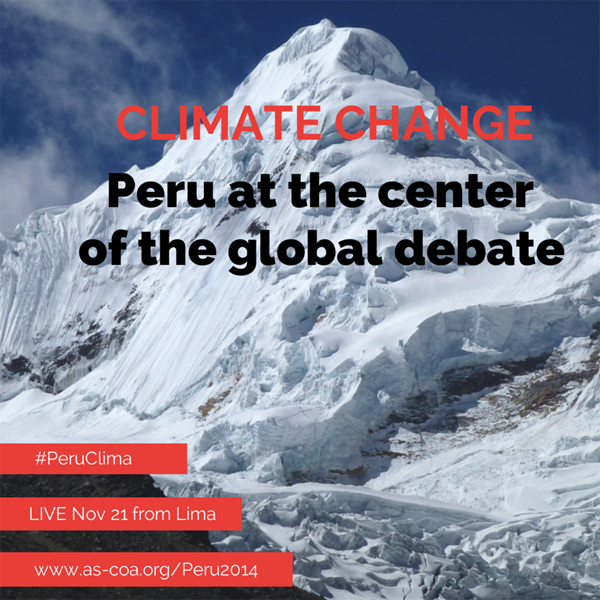Lima 2014 Blog: Peru's Melting Glaciers, Desertification, and Deforestation
Find out what environmental issues are at stake, and what’s being done to fix them.
With 27 out of 32 climatic zones and 5 percent of the world’s freshwater, Peru is the world’s third-most vulnerable country when it comes to climate change. An unusual demographic distribution is accelerating the pace at which water and fertile soils are depleted, while also threatening the biodiversity that inhabits coastal, mountainous, and rainforest ecosystems. Though the country’s economy grew significantly in recent years, some caution that environmental issues could eclipse progress. Below are some of the critical environmental problems the South American country is facing, and steps the government is taking.
Water Stress and Melting Glaciers
Peru has two significant water problems. First, despite having one of the largest proportions of freshwater per person worldwide, 65 percent of the population relies on a single zone of surface waters providing just 1.8 percent of the country’s water resources. This water shortage, concentrated in the arid Pacific coast, is heightened by climate change, which is projected to make precipitation 10 percent more irregular by 2030. Typically, 70 percent of the country’s precipitation falls between December and March, which means a longer dry season could deliver a blow to agricultural production.
Adding to the stress is the state of the country’s sanitation and sewage system. For example, in 2012, less than half of the country’s waste water was treated.
Secondly, over the past four decades, Peru lost 40 percent of its glaciers, which make up 71 percent of the world’s tropical glaciers. Currently spanning 501 square miles (1,299 square kilometers), the glaciers’ melting rate will likely accelerate if Peru’s temperature rises 1.8°F (1°C ) by 2030, as expected. New lagoons of melted ice increase the probability of avalanches, mudslides, and flooding disasters.
Desertification
Desertification is another consequence of climate change accentuated by Peru’s distribution of natural resources per its population. The process by which soil is degraded until it’s irreparable affects 83 percent of the country’s population, which is concentrated in the 40 percent of lands classified as desert or dryland. Though precipitation is low in these zones, the land can sustain some agriculture. However, climate variations and human activities, like over-cultivation, drain the soil’s fertility. By 2050, the World Bank projects the northern, central, and southern part of the country will see a 10-, 19-, and 14-percent drop in precipitation respectively. Consequently, more people will likely migrate to the Amazon region where freshwater is abundant, augmenting soil decay.
Deforestation
Peru’s forests span 283,012 square miles (733,000 square kilometers), making it the second-most forested country in South America, and ninth worldwide. Between 2000 and 2010, Peru lost approximately 425 square miles (1,100 square kilometers) of forest a year. The Ministry of the Environment (MINAM) says small-scale farmers drive 75 percent of deforestation, as they are unaware that misusing the soil alters the carbon stock of the land. Forests are Peru’s principal agent in absorbing greenhouse gases, and the change of land use inversely releases more greenhouse gases than all other emission sources. In 2013, it constituted 41 percent of the country’s total carbon dioxide emissions.
Indirect factors, such as migration to the Amazon and a lacking governmental presence, are also contributing to deforestation.
A National Strategy
To address issues holistically, Peru developed its National Climate Change Strategy (ENCC) in 2003. The ENCC creates a framework of objectives for state, regional, and local entities in addressing climate change. Primary objectives include increasing the public’s knowledge on issues and encouraging coordination between state, civic, and economic agents. With the Ministry of Defense overseeing all projects, the government aims to reduce 47.5 percent of the country’s greenhouse gas emissions by 2021.
Issue-specific strategies include new investigative units like the National Institute of Glaciers and Mountainous Ecosystems to preserve glaciers through research and development of climate policies. To address the shortage of water in cities, the National Plan of Environmental Action set goals to treat 50 percent of all waste water by 2017, and 100 percent by 2021. Additionally, half of used water should be recycled by 2021.
A government strategy to combat desertification identifies four points to guide efforts of the public and private sectors: improving the quality of life of affected communities, boosting ecological conditions, realizing global benefits, and mobilizing financial and technical resources.
Regarding deforestation, the government is preserving 208,495 square miles (540,000 square kilometers) under the National Plan of the Conservation of Forests. The international REDD+ program is also helping Peru restore and conserve forests through regional projects promoting sustainable practices among communities and by cutting carbon emissions. In the September 2014 Climate Summit, Germany and Norway agreed to support Peru in its efforts to reduce deforestation. Norway, for example, will provide $47 million to help reduce greenhouse gases.
The upcoming twentieth session of the UN Framework Convention on Climate Change in Lima, Peru this December could also lead to further international cooperation in combating climate change.







